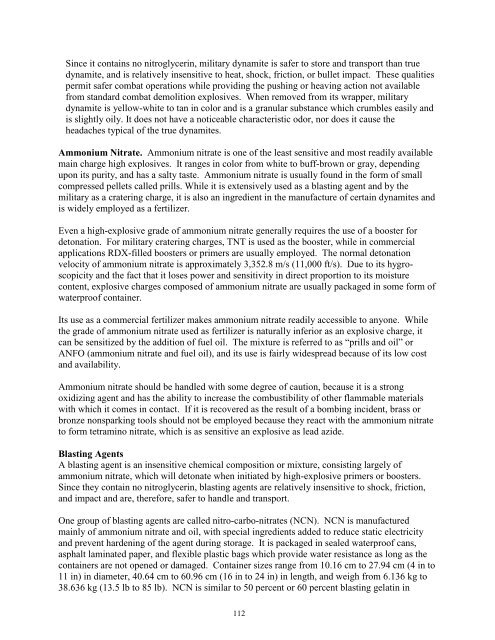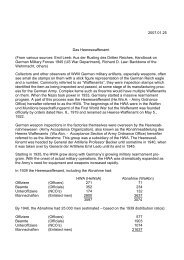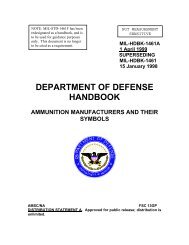Explosives-Nature, Use, Effects and Application.pdf
Explosives-Nature, Use, Effects and Application.pdf
Explosives-Nature, Use, Effects and Application.pdf
You also want an ePaper? Increase the reach of your titles
YUMPU automatically turns print PDFs into web optimized ePapers that Google loves.
Since it contains no nitroglycerin, military dynamite is safer to store <strong>and</strong> transport than true<br />
dynamite, <strong>and</strong> is relatively insensitive to heat, shock, friction, or bullet impact. These qualities<br />
permit safer combat operations while providing the pushing or heaving action not available<br />
from st<strong>and</strong>ard combat demolition explosives. When removed from its wrapper, military<br />
dynamite is yellow-white to tan in color <strong>and</strong> is a granular substance which crumbles easily <strong>and</strong><br />
is slightly oily. It does not have a noticeable characteristic odor, nor does it cause the<br />
headaches typical of the true dynamites.<br />
Ammonium Nitrate. Ammonium nitrate is one of the least sensitive <strong>and</strong> most readily available<br />
main charge high explosives. It ranges in color from white to buff-brown or gray, depending<br />
upon its purity, <strong>and</strong> has a salty taste. Ammonium nitrate is usually found in the form of small<br />
compressed pellets called prills. While it is extensively used as a blasting agent <strong>and</strong> by the<br />
military as a cratering charge, it is also an ingredient in the manufacture of certain dynamites <strong>and</strong><br />
is widely employed as a fertilizer.<br />
Even a high-explosive grade of ammonium nitrate generally requires the use of a booster for<br />
detonation. For military cratering charges, TNT is used as the booster, while in commercial<br />
applications RDX-filled boosters or primers are usually employed. The normal detonation<br />
velocity of ammonium nitrate is approximately 3,352.8 m/s (11,000 ft/s). Due to its hygroscopicity<br />
<strong>and</strong> the fact that it loses power <strong>and</strong> sensitivity in direct proportion to its moisture<br />
content, explosive charges composed of ammonium nitrate are usually packaged in some form of<br />
waterproof container.<br />
Its use as a commercial fertilizer makes ammonium nitrate readily accessible to anyone. While<br />
the grade of ammonium nitrate used as fertilizer is naturally inferior as an explosive charge, it<br />
can be sensitized by the addition of fuel oil. The mixture is referred to as “prills <strong>and</strong> oil” or<br />
ANFO (ammonium nitrate <strong>and</strong> fuel oil), <strong>and</strong> its use is fairly widespread because of its low cost<br />
<strong>and</strong> availability.<br />
Ammonium nitrate should be h<strong>and</strong>led with some degree of caution, because it is a strong<br />
oxidizing agent <strong>and</strong> has the ability to increase the combustibility of other flammable materials<br />
with which it comes in contact. If it is recovered as the result of a bombing incident, brass or<br />
bronze nonsparking tools should not be employed because they react with the ammonium nitrate<br />
to form tetramino nitrate, which is as sensitive an explosive as lead azide.<br />
Blasting Agents<br />
A blasting agent is an insensitive chemical composition or mixture, consisting largely of<br />
ammonium nitrate, which will detonate when initiated by high-explosive primers or boosters.<br />
Since they contain no nitroglycerin, blasting agents are relatively insensitive to shock, friction,<br />
<strong>and</strong> impact <strong>and</strong> are, therefore, safer to h<strong>and</strong>le <strong>and</strong> transport.<br />
One group of blasting agents are called nitro-carbo-nitrates (NCN). NCN is manufactured<br />
mainly of ammonium nitrate <strong>and</strong> oil, with special ingredients added to reduce static electricity<br />
<strong>and</strong> prevent hardening of the agent during storage. It is packaged in sealed waterproof cans,<br />
asphalt laminated paper, <strong>and</strong> flexible plastic bags which provide water resistance as long as the<br />
containers are not opened or damaged. Container sizes range from 10.16 cm to 27.94 cm (4 in to<br />
11 in) in diameter, 40.64 cm to 60.96 cm (16 in to 24 in) in length, <strong>and</strong> weigh from 6.136 kg to<br />
38.636 kg (13.5 lb to 85 lb). NCN is similar to 50 percent or 60 percent blasting gelatin in<br />
112




